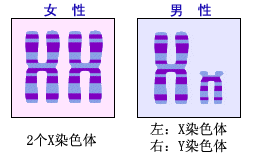|
性-人类性的基本层面
Sex
- Basic Aspects of Human Sexuality
|
|
染色体的功能:染色体如何决定一个人的性?
|
|
 人体细胞含46条染色体,其中的2条决定着一个人的性:女性有两条X染色体(44+XX);男性有一条X染色体和一条Y染色体(44+XY)。然而,卵细胞在成熟和准备受精之前,她减少了一半的染色体(结果是:22+X)。同样的,精子在达到完全成熟之前,他也只有一半的染色体(结果是:22+X或22+Y)。在受/授精期间,保留那一半染色体的卵子和精子发生融合,形成一个新的完整细胞。所以,这个新细胞可能含有44+XX或44+XY染色体。因此,新细胞将会要么发育成女性个体,要么发育成男性个体。但是,在胚胎早期,我们在外观上区分不了男女个体。 人体细胞含46条染色体,其中的2条决定着一个人的性:女性有两条X染色体(44+XX);男性有一条X染色体和一条Y染色体(44+XY)。然而,卵细胞在成熟和准备受精之前,她减少了一半的染色体(结果是:22+X)。同样的,精子在达到完全成熟之前,他也只有一半的染色体(结果是:22+X或22+Y)。在受/授精期间,保留那一半染色体的卵子和精子发生融合,形成一个新的完整细胞。所以,这个新细胞可能含有44+XX或44+XY染色体。因此,新细胞将会要么发育成女性个体,要么发育成男性个体。但是,在胚胎早期,我们在外观上区分不了男女个体。
|
|
The Role of Chromosomes:
How do the chromosomes determine a person's sex?
|
|
Human body cells contain 46 chromosomes, of which 2 determine a person's sex: In the female body they are two X-chromosomes (44+XX), in the male body they are one X-chromosome and one Y-chromosome (44+XY). However, before an egg cell matures and becomes ready for fertilization, it loses half of its chromosomes (result: 22+X). Similarly, before it reaches its full maturity, a sperm cell loses half its chromosomes (result: either 22+X or 22+Y). During fertilization the two remaining halves unite to form a new complete cell. Thus, the new cell may have either 44+XX or 44+XY chromosomes. Accordingly, it will develop in the direction of either a female or male individual. However, at the embryonic stage, the two are still outwardly indistinguishable. |

